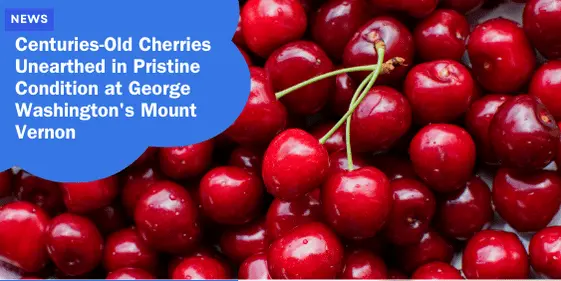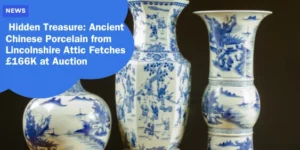Centuries-Old Cherries Unearthed in Pristine Condition at George Washington’s Mount Vernon

Nestled along the picturesque banks of the Potomac River, George Washington’s Mount Vernon estate remains a treasure trove of American history.
Recently, an extraordinary discovery was made during an archaeological dig connected to a major restoration project at the mansion.
Dozens of bottles containing cherries and other berries, astonishingly preserved for over 250 years, were unearthed from storage pits.
This remarkable find not only offers a window into the past but also underscores the meticulous care that went into food preservation at the time.
An Unprecedented Archaeological Find
The principal archaeologist at Mount Vernon, Jason Boroughs, expressed his amazement at the discovery.
“Finding fresh fruit essentially unchanged after 250 years is truly remarkable,” Boroughs remarked.
“All the conditions have to align perfectly for something like that to occur.”
Indeed, such a discovery is virtually unprecedented, shedding light on food preservation techniques that were remarkably advanced for their time.
The Examination and Testing of the Bottles
The unearthed bottles, some containing whole pieces of fruit recognizable as cherries, and others holding gooseberries or currants, were found impeccably preserved.
To better understand the find, Mount Vernon has partnered with the U.S. Department of Agriculture.
Together, they are conducting DNA tests on the fruit to confirm their identities.
More than 50 cherry pits recovered from the bottles are also being examined to determine if they can be planted, although USDA plant geneticist Benjamin Gutierrez noted the challenges.
“It’s kind of a long shot,” Gutierrez said, given that seeds preserve best when dry, whereas the found samples were waterlogged.
Analyzing Preservation Techniques
In addition to DNA analysis, chemical tests are being conducted to identify any particular spices or ingredients used in the preservation process.
This may reveal the methods employed by the plantation’s kitchen staff, who were instrumental in preserving the fruit.
Historical records indicate that George and Martha Washington had a fondness for cherries, especially when mixed with brandy, as shown by
Martha’s recipe for a “cherry bounce” cocktail—a beverage Washington himself enjoyed on trips.
Life and Labor at Mount Vernon
The success of this incredible preservation work reflects the high caliber of skill present in Mount Vernon’s kitchens, which were run by enslaved individuals.
An enslaved woman named Doll, who came to Mount Vernon with Martha Washington in 1758, oversaw the kitchen operations.
Boroughs highlighted the skill needed for preservation efforts, noting, “Enslaved individuals responsible for tending the trees, harvesting the fruit, and working in the kitchen would likely have overseen and carried out this process.”
The Context of the Discovery
The bottles were uncovered during a $40 million revitalization project at Mount Vernon, timed for completion by the nation’s 250th birthday in 2026.
Boroughs explained the necessity of the excavation, noting, “When we do archaeology, it’s destructive.
The structural repairs required for the mansion necessitated ground disturbance, leading to this serendipitous find.
The bottles have been dated to pre-1775, based on the timing of the mansion’s expansion which covered the area with a brick floor.
The Scale of the Discovery
Initially, the archaeological team announced the discovery of two bottles in April.
However, as the excavation progressed, the number increased to 35 bottles found in six distinct storage pits.
Of these, six were broken, but the remaining 29 stayed intact.
Within the bottles, 12 contained cherries, 16 held other berries believed to be currants and gooseberries, and one larger bottle included both cherries and berries.
This extensive discovery highlights the scale and sophistication of Mount Vernon’s food preservation efforts.
Future Prospects and Historical Insight
While the likelihood of growing new cherry trees from the recovered pits remains low, the bottles themselves provide a wealth of information.
The collaboration with the USDA and ongoing scientific analyses may reveal more about the horticultural practices and culinary preferences of George Washington’s time.
With the estate’s ongoing restoration and archaeological projects, further discoveries may still await.
Conclusion: Echoes of the Past
The unearthing of perfectly preserved cherries at Mount Vernon offers an awe-inspiring glimpse into the storied past of George Washington’s estate.
The robust preservation methods, the skilled labor of the enslaved kitchen staff, and the unexpected alignment of conditions highlight a fascinating chapter of American history.
As Mount Vernon continues its restoration efforts, these finds not only enrich our understanding of the 18th-century lifestyle but also honor the enduring legacy of those who lived and worked on the estate.
For history enthusiasts, culinary historians, and scholars alike, this discovery emphasizes the intricate interplay between daily life and historical preservation.
As we celebrate the nation’s 250th birthday, these cherries stand as a testament to the remarkable journey of preservation—both of food and history—ensuring that the stories from George Washington’s era continue to captivate and educate future generations.






